Day-672
Quiz-summary
0 of 5 questions completed
Questions:
- 1
- 2
- 3
- 4
- 5
Information
DAILY MCQ
You have already completed the quiz before. Hence you can not start it again.
Quiz is loading...
You must sign in or sign up to start the quiz.
You have to finish following quiz, to start this quiz:
Results
0 of 5 questions answered correctly
Your time:
Time has elapsed
You have reached 0 of 0 points, (0)
Categories
- Not categorized 0%
- 1
- 2
- 3
- 4
- 5
- Answered
- Review
-
Question 1 of 5
1. Question
1. Titanomagnetite ore is the primary source of which of the following elements?
Correct
Answer: D
Explanation:
Vanadium:
• Recently, researchers at the Geological Survey of India (GSI) discovered vanadium, a critical mineral from the Gulf of Khambhat in Gujarat.
• Titanomagnetite – ore containing vanadium has been identified in samples taken from the Gulf of Khambhat.
• Titanomagnetite is a primary source of the element (88% of the world’s vanadium is extracted from it) and is formed when molten lava cools rapidly.
• According to GSI, deposits in the gulf were drained from the Deccan basalt mainly through the rivers of Narmada and Tapi.
• It is a chemical element with the symbol “V” and the atomic number 23 and is classified as a transition metal.
• It is an abundant element in the earth’s crust, ranking 22nd in position in the upper continental crust.
• It is listed as one of the 30 critical minerals identified by the Government of India.
• It is very ductile (can be drawn into wires), malleable (can be hammered into thin sheets), and resistant to corrosion.
• It does not react with water or oxygen at room temperature.
• Brazil is the world’s largest exporter of vanadium (one-fourth of total exports), with Russia and South Africa as the next exporters.
• China has the highest vanadium reserves and producer in the world as of 2022.
• Applications: Used in vanadium redox flow batteries, a type of rechargeable battery, Used as an alloying element in steel production, used as catalysts in the production of chemicals, plastics, Vanadium alloys are also used to make nuclear reactors because of their low neutron absorbing properties, It is used for the treatment of prediabetes, and diabetes, Used in the manufacture of aerospace and aviation components, Used in the production of pigments, ceramics, and as a reducing agent in metallurgy.Incorrect
Answer: D
Explanation:
Vanadium:
• Recently, researchers at the Geological Survey of India (GSI) discovered vanadium, a critical mineral from the Gulf of Khambhat in Gujarat.
• Titanomagnetite – ore containing vanadium has been identified in samples taken from the Gulf of Khambhat.
• Titanomagnetite is a primary source of the element (88% of the world’s vanadium is extracted from it) and is formed when molten lava cools rapidly.
• According to GSI, deposits in the gulf were drained from the Deccan basalt mainly through the rivers of Narmada and Tapi.
• It is a chemical element with the symbol “V” and the atomic number 23 and is classified as a transition metal.
• It is an abundant element in the earth’s crust, ranking 22nd in position in the upper continental crust.
• It is listed as one of the 30 critical minerals identified by the Government of India.
• It is very ductile (can be drawn into wires), malleable (can be hammered into thin sheets), and resistant to corrosion.
• It does not react with water or oxygen at room temperature.
• Brazil is the world’s largest exporter of vanadium (one-fourth of total exports), with Russia and South Africa as the next exporters.
• China has the highest vanadium reserves and producer in the world as of 2022.
• Applications: Used in vanadium redox flow batteries, a type of rechargeable battery, Used as an alloying element in steel production, used as catalysts in the production of chemicals, plastics, Vanadium alloys are also used to make nuclear reactors because of their low neutron absorbing properties, It is used for the treatment of prediabetes, and diabetes, Used in the manufacture of aerospace and aviation components, Used in the production of pigments, ceramics, and as a reducing agent in metallurgy. -
Question 2 of 5
2. Question
2. The region having this type of climate has distinct dry and wet seasons. The landscape is typified by tall grass and short trees. Trees have broad trunks with water storing devices. Most of the communities living in these regions practice pastoralism. However, the cattle often become victims of diseases like sleeping sickness.
Which of the following climates is described in the above paragraph?Correct
Answer: C
Explanation:
The Savanna or Sudan Climate-
● It is a transitional type of climate found between the equatorial forest and the trade wind hot deserts.
● It is best developed in Sudan, hence the name the Sudan Climate.
Distribution of Sudan type climate:

Rainfall in Savannah:
● Mean annual rainfall is from 80 to 160 cm.
● It keeps on decreasing as we move away from the equator.
Temperature:
● The mean annual temperature is greater than 18 degrees C.
● Highest temperatures are found with the high sun season. Days are hot and nights are cold. Therefore, an extreme diurnal range of temperature is found.
Vegetation:
● The tall grasses with short trees are found here.
● The trees are deciduous, shedding their leaves in the cool, dry season to prevent excessive loss of water.
● Trees usually have broad trunks, with water-storing adaptability which saves them in dry summers.
The economy of Sudan-type climatic region:
● Many tribes live in this climate.
● Most of the economy is dependent on animal rearing and agriculture is barely practised.
⮚ Example – The Masai tribe of East African Plateau are pastoralists, who rear cattle and don’t kill them for meat.
● Cattle, sometimes, are exposed to zoonotic diseases like sleeping sickness.Incorrect
Answer: C
Explanation:
The Savanna or Sudan Climate-
● It is a transitional type of climate found between the equatorial forest and the trade wind hot deserts.
● It is best developed in Sudan, hence the name the Sudan Climate.
Distribution of Sudan type climate:


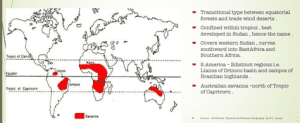
Rainfall in Savannah:
● Mean annual rainfall is from 80 to 160 cm.
● It keeps on decreasing as we move away from the equator.
Temperature:
● The mean annual temperature is greater than 18 degrees C.
● Highest temperatures are found with the high sun season. Days are hot and nights are cold. Therefore, an extreme diurnal range of temperature is found.
Vegetation:
● The tall grasses with short trees are found here.
● The trees are deciduous, shedding their leaves in the cool, dry season to prevent excessive loss of water.
● Trees usually have broad trunks, with water-storing adaptability which saves them in dry summers.
The economy of Sudan-type climatic region:
● Many tribes live in this climate.
● Most of the economy is dependent on animal rearing and agriculture is barely practised.
⮚ Example – The Masai tribe of East African Plateau are pastoralists, who rear cattle and don’t kill them for meat.
● Cattle, sometimes, are exposed to zoonotic diseases like sleeping sickness. -
Question 3 of 5
3. Question
3. Consider the following pairs:
Lakes – Type of landforms
1. Ribbon lake – Glacial landform
2. Lagoon lake – Coastal landform
3. Kettle lake – Riverine landform
How many of the above pairs are correctly matched?Correct
Answer: B
Explanation: Only Pair 3 is matched incorrectly
Pair 1 is matched correctly:
Ribbon Lake:
● A ribbon lake is a long, narrow lake found in glacial valleys.
● They are formed in locations where the glacier moved over soft rock.
● Harder rock higher up the valley is left relatively untouched, so ribbon lakes form in the bottom where soft rock has been eroded by the glacier.


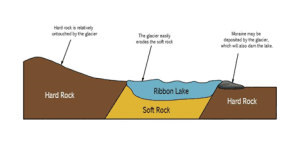
Pair 2 is matched correctly:
Lagoon Lake:
● A lagoon is a body of water separated from larger bodies of water by a natural barrier.
● Lagoons are separated from larger bodies of water by sandbars, barrier reefs, coral reefs, or other natural barriers.
● The word “lagoon” derives from the Italian word laguna, which means “pond” or “lake.”
Types:
● There are two types of lagoons: atoll and coastal.
⮚ Atoll lagoons form when an island completely subsides beneath the water, leaving a ring of coral that continues to grow upwards. At the center of the ring is a body of water that is often deep. The combination of coral growth and water creates a lagoon. It may take as long as 300,000 years for an atoll formation to occur.
⮚ Coastal lagoons form along gently sloping coasts. They are generally shallower than atoll lagoons and tend to be separated from the ocean by an island, reef, or sand bank. Most of the time, coastal lagoons are connected to the ocean by an inlet.


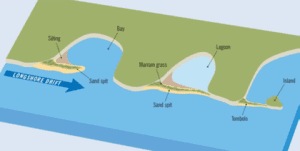
Pair 3 is matched incorrectly: Kettle lakes are a feature of glacial topography.
Kettle Lake:
● A kettle lake is a depression or hole in an outwash plain formed by retreating glaciers or draining floodwaters.
● The kettles are formed because of blocks of dead ice left behind by retreating glaciers, which become surrounded by sediment deposited by meltwater streams as there is increased friction.
● The ice becomes buried in the sediment and when the ice melts, a depression is left called a kettle hole, creating a dimpled appearance on the outwash plain.


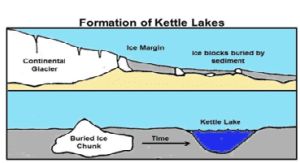 Incorrect
Incorrect
Answer: B
Explanation: Only Pair 3 is matched incorrectly
Pair 1 is matched correctly:
Ribbon Lake:
● A ribbon lake is a long, narrow lake found in glacial valleys.
● They are formed in locations where the glacier moved over soft rock.
● Harder rock higher up the valley is left relatively untouched, so ribbon lakes form in the bottom where soft rock has been eroded by the glacier.



Pair 2 is matched correctly:
Lagoon Lake:
● A lagoon is a body of water separated from larger bodies of water by a natural barrier.
● Lagoons are separated from larger bodies of water by sandbars, barrier reefs, coral reefs, or other natural barriers.
● The word “lagoon” derives from the Italian word laguna, which means “pond” or “lake.”
Types:
● There are two types of lagoons: atoll and coastal.
⮚ Atoll lagoons form when an island completely subsides beneath the water, leaving a ring of coral that continues to grow upwards. At the center of the ring is a body of water that is often deep. The combination of coral growth and water creates a lagoon. It may take as long as 300,000 years for an atoll formation to occur.
⮚ Coastal lagoons form along gently sloping coasts. They are generally shallower than atoll lagoons and tend to be separated from the ocean by an island, reef, or sand bank. Most of the time, coastal lagoons are connected to the ocean by an inlet.



Pair 3 is matched incorrectly: Kettle lakes are a feature of glacial topography.
Kettle Lake:
● A kettle lake is a depression or hole in an outwash plain formed by retreating glaciers or draining floodwaters.
● The kettles are formed because of blocks of dead ice left behind by retreating glaciers, which become surrounded by sediment deposited by meltwater streams as there is increased friction.
● The ice becomes buried in the sediment and when the ice melts, a depression is left called a kettle hole, creating a dimpled appearance on the outwash plain.



-
Question 4 of 5
4. Question
4. It is mainly a rainfed kharif crop, however, it is also grown as a rabi crop in some of the southern states. It requires 50-100 cm of rainfall and frost-free weather. Sunshine after rainfall is very useful for this crop. Karnataka is the largest producer of this crop in India.
Which of the following crops is described in the above paragraph?Correct
Answer: D
Explanation: Maize is described in the above paragraph
Maize:
● Maize is an inferior grain which is used both as food and fodder. Its grain provides for obtaining starch and glucose. Its stalk is fed to cattle.
Conditions of growth:
● Maize can be grown under varied climatic and soil conditions.
● Maize is mainly a rainfed kharif crop which is sown just before the onset of monsoon and is harvested after the retreat of the monsoon.
● In Tamil Nadu, it is a rabi crop and is sown a few weeks before the onset of winter rainy season in September and October.
● It requires 50-100 cm of rainfall, and it cannot be grown in areas of more than 100 cm of rainfall.
● In areas of less rainfall, the crop is irrigated.
⮚ Example – More than half of the maize area in Punjab and Karnataka is irrigated.Incorrect
Answer: D
Explanation: Maize is described in the above paragraph
Maize:
● Maize is an inferior grain which is used both as food and fodder. Its grain provides for obtaining starch and glucose. Its stalk is fed to cattle.
Conditions of growth:
● Maize can be grown under varied climatic and soil conditions.
● Maize is mainly a rainfed kharif crop which is sown just before the onset of monsoon and is harvested after the retreat of the monsoon.
● In Tamil Nadu, it is a rabi crop and is sown a few weeks before the onset of winter rainy season in September and October.
● It requires 50-100 cm of rainfall, and it cannot be grown in areas of more than 100 cm of rainfall.
● In areas of less rainfall, the crop is irrigated.
⮚ Example – More than half of the maize area in Punjab and Karnataka is irrigated. -
Question 5 of 5
5. Question
5. Consider the following statements:
1. Haematite is the best quality iron ore among all followed by magnetite.
2. Most of the Haematite ore is found in southern states, while magnetite ore is found in eastern states of India.
3. India is the fourth largest producer of iron ore worldwide.
4. Odisha is the largest producer of iron ore in India.
How many of the above statements are correct?Correct
Answer: C
Explanation:
Varieties of iron ores found in India:
The following four varieties of iron ore are obtained in India-
a. Haematite
b. Magnetite
c. Limonite
d. Siderite


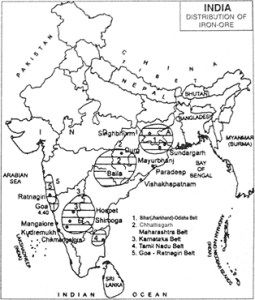
Statement 1 is correct:
● The haematite is the best quality of iron ore with about 70 percent metallic content and occurs as massive, hard compact and bumpy ore having reddish or coral red colour.
● Magnetite, also known as ‘black ore’, due to its blackish colour, is the second-best ore, next only to haematite with metallic content varying from 60 to 70 percent.
Statement 2 is incorrect:
Haematite resource regions:
● Most of the haematite ores are found in Dharwad and Cuddapah rock systems of the peninsular India.
● Over 80 percent of the haematite ores are concentrated in eastern parts of India comprising important iron ore producing states of Odisha, Jharkhand , Chhattisgarh and Andhra Pradesh. In the western regions, the major concentration is in Karnataka, Maharashtra and Goa.
Magnetite resource regions:
● Magnetite ores are majorly found in the Dharwad and Cuddapah systems of peninsular India.
Statement 3 is correct:
● Australia, Brazil, China, India and Russia are the top five countries, together accounting for more than 80% of the total world’s iron ore output.
Statement 4 is correct:
● Odisha accounts for 57% of the country’s iron ore production.
● Production in the state has increased from 3,789 million tonne in 2000 to 9,737 million tonne in the year 2022-23.Incorrect
Answer: C
Explanation:
Varieties of iron ores found in India:
The following four varieties of iron ore are obtained in India-
a. Haematite
b. Magnetite
c. Limonite
d. Siderite



Statement 1 is correct:
● The haematite is the best quality of iron ore with about 70 percent metallic content and occurs as massive, hard compact and bumpy ore having reddish or coral red colour.
● Magnetite, also known as ‘black ore’, due to its blackish colour, is the second-best ore, next only to haematite with metallic content varying from 60 to 70 percent.
Statement 2 is incorrect:
Haematite resource regions:
● Most of the haematite ores are found in Dharwad and Cuddapah rock systems of the peninsular India.
● Over 80 percent of the haematite ores are concentrated in eastern parts of India comprising important iron ore producing states of Odisha, Jharkhand , Chhattisgarh and Andhra Pradesh. In the western regions, the major concentration is in Karnataka, Maharashtra and Goa.
Magnetite resource regions:
● Magnetite ores are majorly found in the Dharwad and Cuddapah systems of peninsular India.
Statement 3 is correct:
● Australia, Brazil, China, India and Russia are the top five countries, together accounting for more than 80% of the total world’s iron ore output.
Statement 4 is correct:
● Odisha accounts for 57% of the country’s iron ore production.
● Production in the state has increased from 3,789 million tonne in 2000 to 9,737 million tonne in the year 2022-23.

